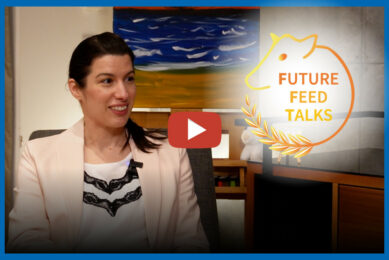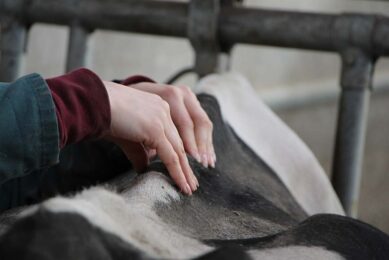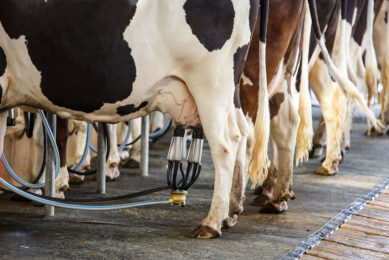Kevin Bellamy from Rabobank

Volatility remains a risk, but the long-term perspectives for dairy are positive, according to Kevin Bellamy from Rabobank.
In the next 5 years, the dairy market remains positive, but not positive in terms of: produce whatever you can and go back to sleep. Dairy farmers should, just like dairy industry experts like himself, take into account a higher volatility than before. So says Kevin Bellamy, former chief dairy analyst and now head of the dairy department at Rabobank in the Netherlands. Dairy Global asked him what the future holds for the dairy market.
The positive outlook is nice, but the higher than expected volatility really is a problem. To the extent that people have difficulty trusting the forecasters. How can they be wrong this often?
“The degree of volatility of the markets has surprised us too. The movements in the market are quicker and more unexpected than foreseen.”
How can this be explained?
“This is partly caused by the fact that production is not well aligned with demand, because markets are not always transparent and farmers do not always get the right feedback. Milk production in Europe has increased significantly since the phasing out of milk quotas. The market has coped with this, but as protein in milk didn’t sell well, disruptions were the result. At the same time, the demand for milk fat grew faster than expected. Dairy farmers didn’t receive the right signals about this on time. Moreover, markets that are partially managed centrally, such as China and Russia, are not always open and transparent. The Russian dairy boycott has had a distorting effect, although this was swiftly back on its feet. Plus, we do not always know exactly what happens in a market such as China.”

Yet you are positive about the situation on the dairy market as a whole. The demand for dairy continues to grow, also on the longer term. How should farmers find their way in a situation like this?
“Firstly, they need a better understanding of what happens around them. They need to develop skills for this themselves, but dairy companies should also inform them better and more timely, giving them time to anticipate. Additionally, dairy farmers should have less debts and should buffer more. Besides this, they must keep an eye on developments in the sustainability field: producing what society wants. They should also keep track of the changes in the European agricultural policy (GLB).“
That is quite an assignment, but what should they do to manage risks? In the past years they have often been told to enter the futures markets, in order to cover themselves against unexpected price risks.
“I think it is quite difficult for farmers to enter the futures markets. This is more something for the RFC’s and Arla’s of this world and the Unilevers and Nestle’s. For farmers it is too complicated and it will take too much effort. Something like this should be done collectively. The members of Dairy Farmers of America (DFA) do it largely via their cooperatives. They cover about 12% of their milk volume on the futures market.”
Not more?
“There must be a certain liquidity on the futures market of course, but this is the volume one works with. You remove peak risks without fixing yourself too much so you will miss profits.”
What can dairy cooperatives do better for their farmers?
“Like I said before, in a volatile market short term communication is important. This allows you to adjust the needed milk volume. In the Netherlands, the volume of the supply is sometimes too high, which leads milk to be sold at excessively low prices. The French show us this should be done differently. It is also demonstrated in the degree of value creation. FrieslandCampina performs well compared to many German companies, but it is not the best. At the French cooperative Sodiaal, 1 litre of milk results in a lot more money.”
But dairy companies can use milk prices to reveal the state of the market and how much milk they can process right?
“Price is not always a good communication tool to steer milk production. Cooperatives strive for a milk price that is as high as possible for their members. FrieslandCampina’s guaranteed price is not a good communication tool. It is a basket of prices, consisting of paid prices and expected prices. This requires at least some additional communication tools.”
Close to the end of the milk quota, dairy farmers were almost unstoppable to produce more. What do you think of that?
“That was tricky. Cooperatives were split. They had to invest in order to be able to process the extra milk supply, but farmers were not or barely prepared to invest more money. They wanted to use their money to expand their sheds. It is not purely or mostly a European problem. We also see it at Fonterra. The question is: where should a cooperation get the extra money to invest in processing capacity? As a cooperative, you don’t want to put yourself on sale. A solution is raising outside funds, but keep control.”
What about the farmers’ own responsibility for milk supply?
“Behavioural differences can be seen. In most European countries farmers work margin driven. Better communication of their dairy companies could improve this. In the Netherlands, dairy farmers mostly work volume driven. Other European dairy farmers often express their surprise about this. “Those Dutch farmers are nuts,” they say. I wouldn’t say it like that, but they do have a point. They should pay more attention to margins, especially because the Netherlands is not a cheap production country. Of all places this is the place where farmers depend on value creation.”
Margin is essential, but the world market does offer room for extra milk?
“Certainly. All indicators imply we can expect a lot of extra demand for dairy in the years to come. China remains a very important importer, but market growth is slowing down there. In the next years it will become a more normal market, but weather circumstances and production costs may cause fluctuations in the import requirements from year to year.”
Will dairy become self-sufficient?
“That is not to be expected. In China, dairy is not a priority – their own milk production will grow by 1 to 1.5% in the coming years, while the demand is growing faster. Besides China, there are other markets where milk consumption will increase, especially in Southeast Asia and in Africa. Central and South America also offer opportunities. India is also mentioned often as a possible export market. But India, the world’s largest dairy producers, has a difficult market, with millions of ‘sacred’ cows, that cannot be slaughtered and are difficult to use efficiently. Plus, the dairy market is much protected.”
You mentioned opportunities on the dairy market, but what are the major risks?
“Apart from the volatility we mentioned before, risks can be found in geopolitics, Brexit; resulting in a changing and diminishing domestic market in the EU. Trade agreements such as the NAFTA to change and protectionism to emerge. These are all developments that can distort trade flows.”
Are these also the issues that large dairy companies are concerned with?
“Ask the CEO’s of large dairy companies what keeps them up at night, the answer is sustainability. That is their major concern, in particular the question of how to handle ngo’s (environmental and animal welfare organisations), of which some are strongly against the dairy sector. Partly under their influence the market for dairy replacements has risen. A company like Danone is slightly moving away from dairy already. The acquisition of the American Whitewave (which produces dairy replacements) has made an impact. Also other producers of dairy replacements show growth.”
At the same time milk fat is revaluated.
“That’s right. Margarine manufacturers are experiencing difficulty because of it. Their products have had the wind in their sails for a long period of time, but this has turned to the advantage of butter. Proteins have a difficult time in certain dairy market segments, but there are plenty of opportunities. In the meantime dairy performs well in terms of sustainability and image. The sector is far ahead of for instance the meat industry and some plant sectors.”
Join 13,000+ subscribers
Subscribe to our newsletter to stay updated about all the need-to-know content in the dairy sector, two times a week.










